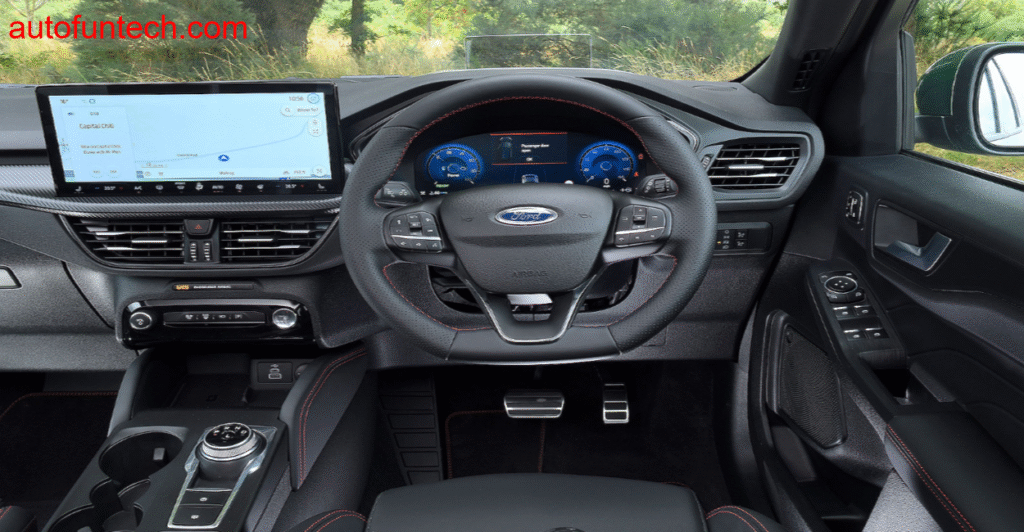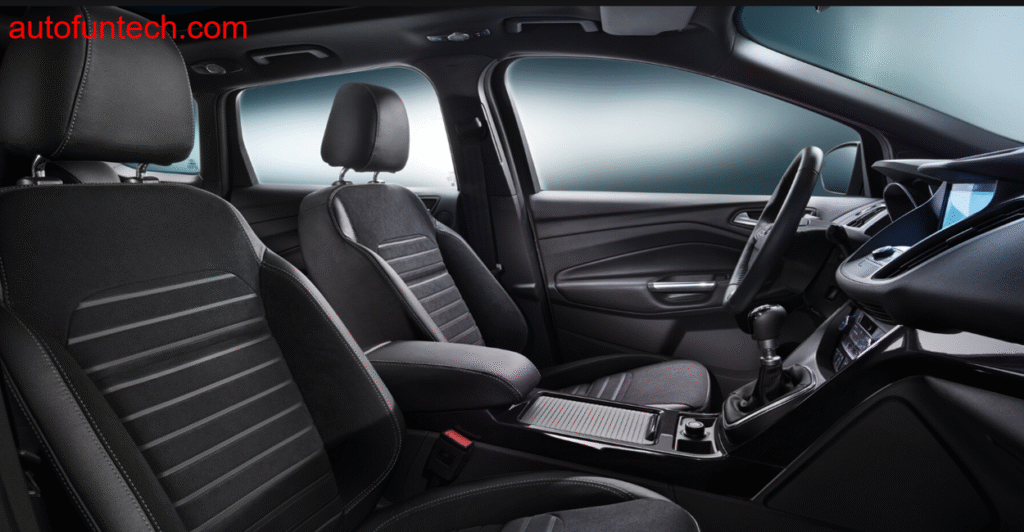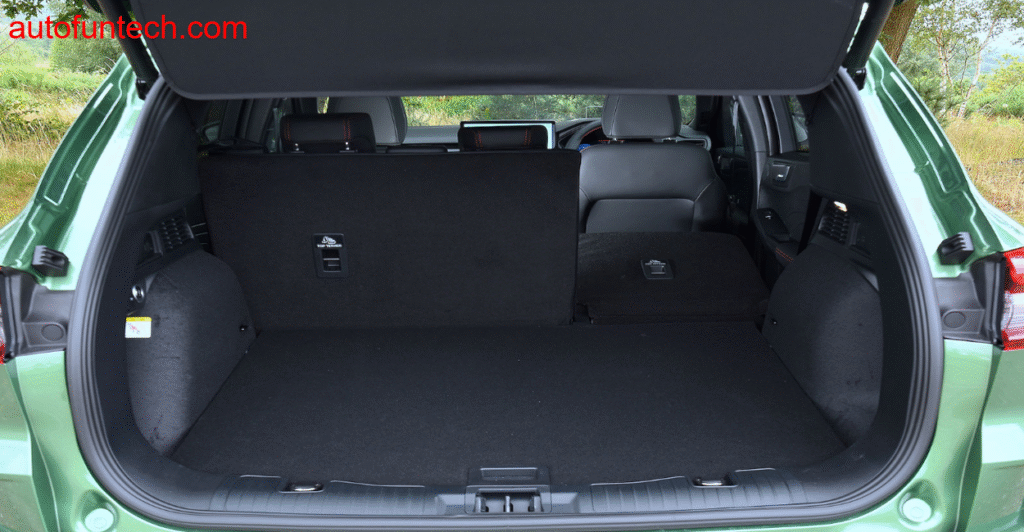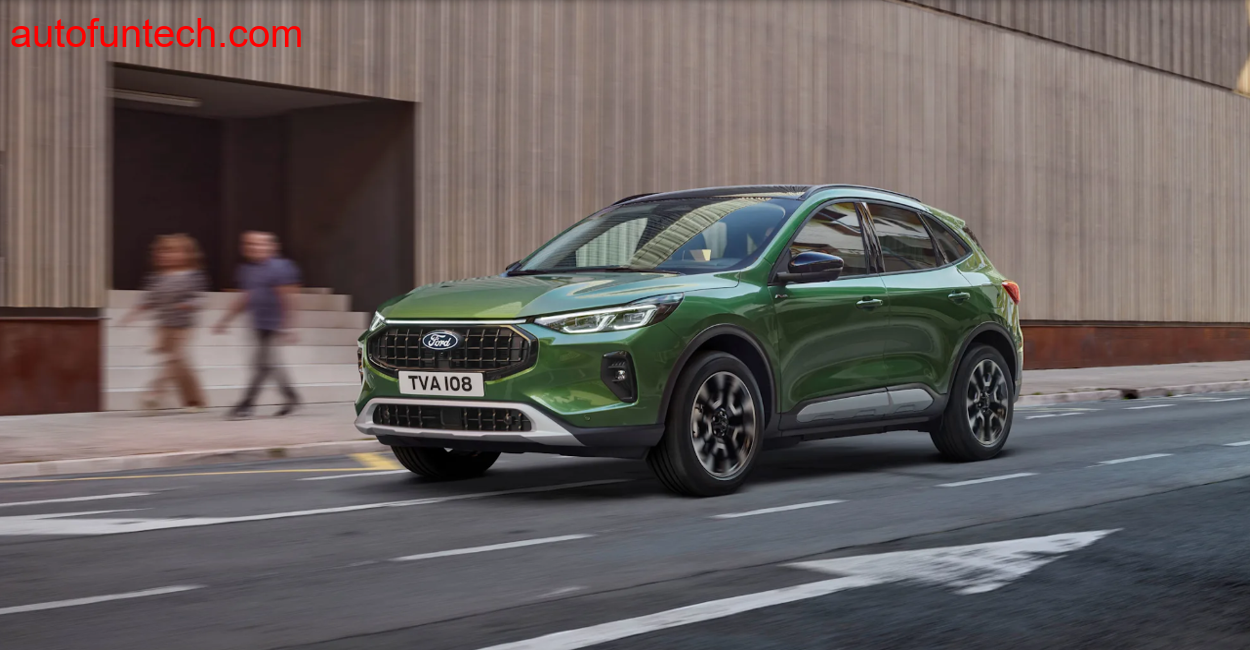First Impressions: A Modern Face with Muscle Behind It
The Kuga is not a head, turner in the exotic sense. But it’s got presence, especially in Titanium trim with the Active package. The redesigned front is cleaner and more angular now, thanks to a two, piece grille and that distinctive horizontal LED light bar. Underbody cladding adds a bit of rugged character, though it’s still clearly designed for the road.
The 18, inch alloys looked good but practical, wrapped in winter, rated Continental ContiWinterContact tires. That gave me some confidence, but I knew the true test wouldn’t come until the gravel turned to something less cooperative.
The cabin welcomed me with a mix of Ford familiarity and new tech ambition. The fully digital 12.3, inch instrument cluster behind the wheel was crisp, and the massive 13.2, inch Sync 4 touchscreen in the center console now housed everything, navigation, climate, media, drive modes, and even towing assistance. That’s also where I noticed the absence of most physical buttons.
Useful? Yes. Distracting while driving? Also yes.
But ergonomics weren’t the point today. Capability was.
Climbing Into the Mountains: Torque, Traction, and Real, World Hybrid Feel
The route to Soiernspitze is not a driver’s road, it’s a survivor’s road. It’s narrow, banked oddly, and scattered with shifting grip. The Kuga’s hybrid system didn’t flinch.
This version packs a 2.5, liter naturally aspirated Duratec engine paired with an electric motor, delivering a combined 183 hp through a continuously variable transmission to all four wheels. That figure isn’t mind, blowing, but the way it delivers power is what stood out.
From a standstill, the torque fill from the electric motor was instant. No delay, no drama, just forward motion. And unlike most hybrids I’ve tested, the CVT didn’t scream when pushed. It kept things hushed until I really leaned on it climbing steep gradients.
When I reached the split between paved access and the trailhead, I flicked into the “Slippery” drive mode, hoping the software knew what I was asking of it. It did. There’s no locking differential here, but torque vectoring and traction control worked overtime, shifting grip between the axles with a smoothness I didn’t expect from a 1.8, ton family SUV. It wasn’t rally driving. It was deliberate, composed, and stable. But more than that, it was trustworthy.

Inside the Kuga: Where Function Balances Finesse
Let’s talk about the space. At 4.6 meters long, the Kuga is flirting with midsize SUV territory, and it shows. The seating position was spot, on for visibility, and with the rear bench slid backward, even my 6’2” cameraman could lounge without brushing the headliner.
There’s 412 liters of usable trunk space with the seats up, expanding to 1,534 liters with the rear seats folded. We packed it full: snow gear, tools, cameras, food, even a foldable e, bike. It swallowed it all.
Materials inside are functional, mostly soft, touch on top, but some hard plastics near the base remind you it’s built to a price. Still, the build quality was tight, no rattles, no squeaks, even over rough alpine switchbacks.
The Sync 4 system deserves praise. Fast, intuitive, and finally up to par with the likes of VW and Hyundai in terms of responsiveness. The only real drawback? Climate controls on the screen. It’s hard to make micro, adjustments while bouncing over frost, heaved roads.
But perhaps my favorite feature, small as it seems, was the heated windshield. It saved me 10 precious minutes every cold start. And in the Alps, that matters.

Fuel Economy and Hybrid Intelligence: Does It Deliver?
Let’s get technical. Over 300 kilometers of mixed driving, 60% alpine roads, 25% autobahn, 15% urban, I averaged 6.6 liters per 100 kilometers. That’s higher than Ford’s WLTP figure of 5.7, but completely fair given the terrain and temperature (hovering around , 4°C most of the time).
In the city of Mittenwald, creeping through traffic in EV, only mode, I was pulling under 5 l/100km, and the transitions between engine and electric were seamless. The regenerative braking system wasn’t adjustable, but it worked predictably, helping top up the tiny 1.1 kWh battery just enough to keep the electric assist ready for the next hill.
On the autobahn, the Kuga revealed its Achilles heel. Above 130 km/h, the fuel economy drops quickly. At 160 km/h, I was burning closer to 8.5 l/100km. That’s expected, but worth knowing.
Still, for a full hybrid, not a plug, in, it held its own. And for a driver like me who mixes mountain climbs with city runs, the math checks out.
Handling, Suspension, and the Reality of “Active” Driving
Here’s where things get personal.
The Kuga is not sporty. Ford says “Active” trim, and while it may have a few visual nods to adventure, it’s still a comfort, focused platform. That said, the steering was precise enough, with decent feedback on snow, dusted curves. I never once felt disconnected.
But the suspension tuning needs refinement. At low speeds over uneven surfaces, especially frozen gravel, the ride was jarring. It felt stiff, legged, refusing to iron out minor imperfections. At higher speeds, that harshness settled down, but I’d hesitate to call the ride “comfortable” on anything but tarmac.
The ADAC evasive maneuver test results lingered in my mind too. I could feel the ESP cutting in early and abruptly on tighter turns. It keeps you safe, but it kills fun. And if you’re someone who likes a bit of lift, off playfulness in a corner, look elsewhere.

Conclusion: A Hybrid That Thinks Practically and Climbs Quietly
Back at the trailhead, after a full day climbing up and rolling down the flanks of Soiernspitze, I leaned against the still, warm hood of the Kuga and smiled.
It’s not perfect. The ride could be more forgiving. The touchscreen needs physical backup. And yes, its behavior in emergency maneuvers isn’t class, leading.
But the Kuga Hybrid is exactly what many drivers need: an honest, spacious, intelligent SUV that thrives in the real world, especially when that world includes snow, altitude, and the kind of roads where fuel efficiency and traction both matter.
I didn’t want more horsepower. I didn’t want louder pipes or a sport mode that tightens fake dampers. I wanted confidence. And the Kuga gave me that.
It climbed the mountain. It brought me down safely. And it did it sipping fuel, not guzzling it.
Sometimes, that’s the story worth telling.
Technical Specifications: 2024 Ford Kuga 2.5 FHEV Titanium AWD
| Specification | Detail |
| Engine Type | 2.5L Duratec Full Hybrid |
| System Power | 183 hp (134 kW) |
| Transmission | CVT (Continuously Variable) |
| Drive Type | All, Wheel Drive |
| Battery Capacity (Net) | 1.1 kWh |
| Acceleration (0, 100 km/h) | 8.3 seconds |
| Top Speed | 196 km/h |
| Combined Consumption (WLTP) | 5.7 L/100 km |
| ADAC Real, World Average | 6.5 L/100 km |
| CO₂ Emissions (WLTP) | 130 g/km |
| Trunk Volume (Seats Up) | 412 liters |
| Trunk Volume (Seats Folded) | 1,534 liters |
| Braked Towing Capacity | 2,100 kg |
| Length x Width x Height | 4,604 mm x 1,882 mm x 1,675 mm |
| Base Price (Germany) | €46,500 (as of Jan 2025) |


Leave a Comment